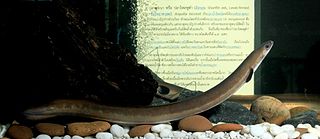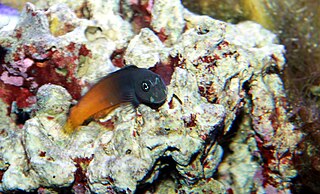
Mackerel is a common name applied to a number of different species of pelagic fish, mostly from the family Scombridae. They are found in both temperate and tropical seas, mostly living along the coast or offshore in the oceanic environment.

Herring are forage fish, mostly belonging to the family of Clupeidae.

Snipe eels are a family, Nemichthyidae, of eels that consists of nine species in three genera. They are pelagic fishes, found in every ocean, mostly at depths of 300–600 m (980–1,970 ft) but sometimes as deep as 4,000 m (13,000 ft). Depending on the species, adults may reach 1–2 m (39–79 in) in length, yet they weigh only 80–400 g (2.8–14.1 oz). They are distinguished by their very slender jaws that separate toward the tips as the upper jaw curves upward. The jaws appear similar to the beak of the bird called the snipe. Snipe eels are oviparous, and the juveniles, called Leptocephali, do not resemble the adults but have oval, leaf-shaped and transparent bodies. Different species of snipe eel have different shapes, sizes and colors. The similarly named bobtail snipe eel is actually in a different family and represented by two species, the black Cyema atrum and the bright red Neocyema erythrosoma.
Heteroconger cobra, sometimes known as the cobra garden eel, is a species of garden eel of the family Congridae, found in the western Central Pacific from Honiara, the Solomon Islands to Port Moresby, Papua New Guinea.

The New Zealand longfin eel, also known as ōrea, is a species of freshwater eel that is endemic to New Zealand. It is the largest freshwater eel in New Zealand and the only endemic species – the other eels found in New Zealand are the native shortfin eel, also found in Australia, and the naturally introduced Australian longfin eel. Longfin eels are long-lived, migrating to the Pacific Ocean near Tonga to breed at the end of their lives. They are good climbers as juveniles and so are found in streams and lakes a long way inland. An important traditional food source for Māori, who name them ōrea, longfin eel numbers are declining and they are classified as endangered, but over one hundred tonnes are still commercially fished each year.

The speckled longfin eel, Australian long-finned eel or marbled eel is one of 15 species of eel in the family Anguillidae. It has a long snake-like cylindrical body with its dorsal, tail and anal fins joined to form one long fin. It usually has a brownish green or olive green back and sides with small darker spots or blotches all over its body. Its underside is paler. It has a small gill opening on each side of its wide head, with thick lips. It is Australia's largest freshwater eel, and the female usually grows much larger than the male. It is also known as the spotted eel.

Anguilla bengalensis bengalensis, the Indian mottled eel, is a subspecies of eel in the genus Anguilla of the family Anguillidae. It is found throughout the Indian subcontinent and neighbouring regions including the East Indies.
Anguilla bengalensis labiata, the African mottled eel, is a subspecies of eel in the genus Anguilla of the family Anguillidae.

The Indonesian shortfin eel is a subspecies of eel in the genus Anguilla of the family Anguillidae. It is found throughout the tropical coastal regions of the Indian Ocean and Western Pacific Ocean.

The mottled eel, also known as the African mottled eel, the Indian longfin eel, the Indian mottled eel, the long-finned eel or the river eel, is a demersal, catadromous eel in the family Anguillidae. It was described by John McClelland in 1844. It is a tropical, freshwater eel which is known from East Africa, Bangladesh, Andaman Islands, Mozambique, Malawi, Sri Lanka, Sumatra, and Indonesia and recently from Madagascar. The eels spend most of their lives in freshwater at a depth range of 3–10 metres, but migrate to the Indian Ocean to breed. Males can reach a maximum total length of 121 centimetres and a maximum weight of 7,000 grams. The eels feed primarily off of benthic crustaceans, mollusks, finfish and worms.

The Indian shortfin eel, Anguilla bicolor pacifica, is a species of eel in the genus Anguilla of the family Anguillidae. The Indian shortfin eel typically lives in fresh water or brackish water. The habitat use of the Indian shortfin eel is dependent on environmental factors.

The giant mottled eel, also known as the marbled eel, is a species of tropical anguillid eel that is found in the Indo-Pacific and adjacent freshwater habitats.

Ecsenius bicolor, commonly known as the flame tail blenny or bicolor blenny, is a blenny from the Indo-Pacific. It frequently makes its way into the aquarium trade. It grows to a size of 11 centimetres (4.3 in) in length.

Eels are ray-finned fish belonging to the order Anguilliformes, which consists of eight suborders, 19 families, 111 genera, and about 800 species. Eels undergo considerable development from the early larval stage to the eventual adult stage and are usually predators.

Fish are very diverse animals and can be categorised in many ways. Although most fish species have probably been discovered and described, about 250 new ones are still discovered every year. According to FishBase about 34,800 species of fish had been described as of February 2022, which is more than the combined total of all other vertebrate species: mammals, amphibians, reptiles and birds.

Nemacheilus anguilla, the eel loach, is a species of ray-finned fish in the genus Nemacheilus which is endemic to the Western Ghats in southern India. It occurs in streams with pebbles and with sandy substrates. It is collected for the aquarium trade but the main threat may come from pollution caused by large numbers of pilgrims which attend temples near the waters in which this species occurs.
Notacanthus is a genus of spiny eels in the family Notacanthidae.

Chilara taylori, the spotted cusk-eel, is a species of cusk-eel found along the eastern coast of the Pacific Ocean where it is found at depths down to around 280 metres (920 ft) from Washington, United States to Ecuador. This species grows to a length of 40.4 centimetres (15.9 in) TL. It is the only known member of its genus.
















